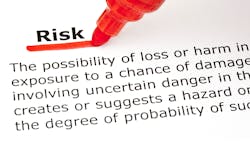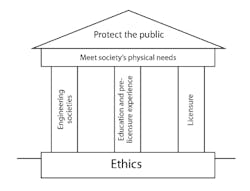Engineering Licensing-Exemptions Put the Public at Unnecessary Risk
The October 2018 and March 2019 crashes of Boeing 737 MAX 8 airliners killed 346 passengers and crewmembers and caused sorrow and grief for many times that number of family members and friends. Those disasters share a common characteristic with many tragedies such as the Ford Pinto fires, the space shuttle Challenger explosion, the GM ignition switch disaster, the Deepwater Horizon oilrig tragedy, amusement ride accidents, the Merrimack Valley gas distribution system fires and Volkswagen’s emissions fraud.
The common characteristic? All the engineering organizations behind these failures were exempt from placing licensed engineers in charge. Engineering did not need to be conducted under the direction of competent and accountable engineers whose paramount ethical and legal responsibility was public protection. Instead, the “engineering” was primarily driven by bottom-line-oriented managers and executives.
Licensing
Understanding how this illogical practice prevails begins with a review of engineering licensing in the U.S. Dent v. West Virginia, a landmark 1889 U.S. Supreme Court case, gave states essentially unlimited power to regulate professions for public-protection purposes.
In 1907, Wyoming became the first U.S. jurisdiction to adopt an engineering licensing law. Other jurisdictions, often stimulated by engineering disasters, followed suit so that by 1950 all 48 states, the then-territories of Alaska and Hawaii, and the District of Columbia had adopted such laws.
To become a Professional Engineer (PE), candidates must earn an accredited engineering degree, complete four years of increasingly responsible experience, and pass two examinations. PEs then become participants in what Richard and Daniel Susskind, authors of The Futures of the Professions, call the grand bargain between a profession’s members and the public.
PEs apply their expertise, experience and judgment in delivering affordable, current and reliable services and put the interests of those they serve ahead of their own. Individuals and organizations contracting for services trust PEs to do those things and grant them exclusivity over a range of services by paying them a fair fee and conferring autonomy on them.
“You can’t escape the responsibility of tomorrow by evading it today.”
—Abraham Lincoln
Ethics Codes
Introducing ethics codes prompts us to ask, what is engineering’s purpose? If the medical profession provides care without doing harm and the legal profession seeks justice within the law, what is engineering’s goal? In my view, engineering’s purpose is to meet society’s physical needs while keeping public protection paramount.
To further define what licensing meant, engineering began to construct, and then build on, a foundation of ethics. The American Institute of Chemical Engineers (AIChE), what became the Institute of Electrical and Electronics Engineers (IEEE), as well as the American Society of Mechanical Engineers (ASME) and American Society of Civil Engineers (ASCE) all created and adopted codes between 1912 and 1914.
Other engineering groups followed, so that today they all admirably state the following, or something very similar: The engineer will “hold paramount the safety, health and welfare of the public.”
Remarkably, more than half a century ago, U.S. engineering had achieved universal licensing laws plus unanimous commitment, via ethics codes, to hold public protection paramount. Engineering was on its way to becoming a profession, on par with any, because it promised to meet society’s physical needs while protecting the public. But did that promise lead to consistent actions on risky engineering projects to protect the public?
Licensure-Exemption Laws
Unfortunately, the answer is no because, beginning in about 1940, three decades after adoption of the first state engineering licensing law and during World War II, many U.S. companies began a campaign to get exemptions for their engineers from mandatory licensing. How would this work?
These employers would be responsible for their engineers’ work and be liable for errors and decisions that caused injuries, deaths and destruction. Liability assumption by manufacturers, industries, utilities and others would “protect” the public. For example, the 346 families who lost parents, spouses, children and siblings in the two recent 737 disasters will receive an average of about $1.45 million from Boeing. Is that enough? Would any amount be enough?
Americans harmed by engineering disasters realize that this “closing the barn door after the horses are gone” approach, while it may provide some justice and financial remuneration for victims, does not bring back the dead, heal the maimed or restore what was destroyed. Furthermore, the inevitable negotiation and litigation forces survivors to relive the tragedy.
Putting profit over public protection, in other than low-risk engineering situations, and accepting unnecessary deaths, injuries and destruction is terrible public policy. However, it persists today in that DC and all states, except Arkansas and Oklahoma, have engineering licensing-exemption laws.
The Licensure-Exemption Law Culture
According to engineer-author Stephen Armstrong, company/organizational “culture wields great power over what people consider permissible and appropriate…culture sends its energy into every corner of the organization, influencing virtually everything.” My consistent, but shorter, definition of culture is: the way things really work around here, especially when the chips are down.
Research reveals that manufacturers, industries, utilities and other organizations that hire engineers to work under licensing-exemption laws tend to develop bottom-line-first cultures, which override public protection. Consider some examples of the culture created by licensing-exemption laws:
- According to Boeing, its engineers reported that PEs were not needed in aircraft design, including the 737 MAX.
- During the design of the Ford Pinto, engineers learned that the explosion risk due to a poorly placed fuel tank could be eliminated for $11 per vehicle, but engineers and management decided that settling accident claims would cost less.
- Morton-Thiokol management was warned by a lead engineer to delay the launch of space shuttle Challenger because of the harmful effect of low temperatures on gaskets. Managers rejected the advice and told the engineer: “Take off your engineering hat and put on your management hat.” This, in effect, killed seven astronauts.
- For a decade, GM engineers brushed off reports that occupants of six car models were being injured or killed because of a faulty ignition switch, which was eventually re-designed.
- Reporter and author Abraham Lustgarten, who studied two decades of British Petroleum operations leading up to the Deepwater Horizon oil rig tragedy, concluded that “oil companies…could not be trusted to police themselves and balance the public good against their own profits.”
- After studying the fires at the Merrimack Valley gas distribution system and recognizing the potential for similar disasters in 30 states because of their license-exemption cultures, the National Transportation Safety Board recommended that all those states “remove the exemption” that caused the Massachusetts tragedy. Several states have done so or are considering that option.
This dangerous bottom line-first culture, like all company cultures, is driven from the top and enters “every corner of the organization, influencing virtually everything.” A bottom line-first culture is especially dangerous in engineering organizations because one engineering failure can injure and kill many. In contrast, if a surgeon errs during an operation, the consequences—however dire—are limited to one or a few individuals.
“It is easy to dodge our responsibilities, but we cannot dodge the consequences of dodging our responsibilities.”
—Sir Josiah Stamp, English economist, industrialist, banker and civil servantShow Me the Data
Interested engineers, as well as other thinking individuals, naturally want to see the data that show how licensing-exemption laws lead to unnecessary injuries, deaths and destruction. I believe this could be done, but it has yet to happen. However, absence of statistical proof does not begin to reduce my and others’ concern for public safety.
Therefore, some colleagues and I apply a powerful “tool” used every day in our engineering work—judgement. My judgement draws on examining engineering disasters, understanding human behavior (especially groupthink), contrasting engineering’s approach with that of most professions, and empathizing with actual and potential victims.
The common U.S. practice of not placing PEs in responsible charge of risky engineering projects would be like:
- Hospitals not placing licensed physicians “in responsible charge” of surgery.
- Law firms not placing licensed attorneys “in responsible charge” of legal services.
- Veterinary clinics not placing licensed vets “in responsible charge” of neutering and spaying.
Of course, those three professions don’t do that. They don’t let physicians, lawyers, and vets practice without licenses. However, that is exactly what engineering does, frequently and sometimes disastrously, across America.
Those who defend licensing-exemptions often note that tragedies sometimes occur even when PEs are in charge, which is true. However, in my judgement, engineering projects guided by PEs are much more likely to protect the public than those guided by non-PEs or non-engineer managers. PEs are more likely to:
- Be competent, partly because continuing education is a condition of maintaining a PE license in 75% of U.S. licensing jurisdictions.
- Behave ethically, mainly because they are subject to the ethics code of the jurisdiction(s) that licensed them, and code violations have legal consequences.
- View themselves as members of a profession whose paramount responsibility is public protection, rather than as being technical employees answerable mainly to corporate directives.
Engineering’s approach to public protection is a predicament. The engineering community’s widespread public-protection-is-paramount claims, via ethics codes, stand in sharp and hypocritical conflict with the equally widespread licensure-exemption laws. If this dilemma stands, the public faces unnecessary risks. We need reform so that competent and accountable PEs who place public protection first are responsible for risky engineering projects.
Reform requires first identifying and understanding any group or organization that supports licensure-exemption laws. That is, who is culpable? Second, reform must begin with describing how change-minded individuals and organizations could dismantle, or at least weaken, the support for those exemptions.
A follow-up installment to this article will outline how to begin that reformation.
Stuart G. Walesh, Ph.D., P.E., Dist.M.ASCE, F.NSPE, an independent consultant, teacher, and author, holds civil engineering degrees and previously worked in the business, government and academic sectors. He provides engineering, management, leadership and education services. His most recent book, on which this article draws, is Engineering’s Public-Protection Predicament (2021). Visit his website or contact him via email.
About the Author
Stuart G. Walesh
Independent consultant, teacher and author
Stuart G. Walesh, Ph.D., P.E., Dist.M.ASCE, F.NSPE, an independent consultant, teacher and author, holds civil engineering degrees and previously worked in the business, government and academic sectors. He provides engineering, management, leadership and education services. His most recent book is Engineering’s Public-Protection Predicament (2021).

